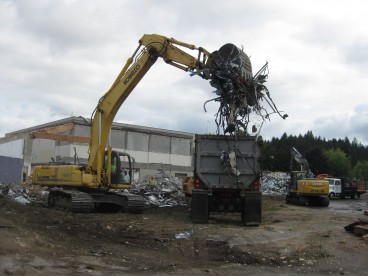This content was published: August 22, 2014. Phone numbers, email addresses, and other information may have changed.
Recycle, recycle, recycle – Building 5 at Rock Creek will rise again, somewhere, somehow
Photos and story by Karen Kane

Building 5 demolition at Rock Creek will take about a month. Fortis Construction aims to recycle up to 98 percent of the debris.
Aug. 22, 2014
By Karen Kane
What goes up must come down, but it doesn’t have to go away, especially if it’s construction waste. Like the great Phoenix, it can rise again, regenerating into a new life, for a new useful purpose.
Nearly 90 percent of all construction waste can be reused or recycled, but at Rock Creek, where Fortis Construction is demolishing part of Building 5 as part of the $374 million voter-approved bond program, more than 96 percent of waste is on tap to be recycled. Recycling construction and demolition debris not only keeps valuable resources out of the landfill, it saves PCC money and at the same time contributes to the college’s earning LEED ratings*.
Fortis, the construction manager and general contractor at Rock Creek, is separating metal, glass, concrete, asphalt and wood from a 25,000 square-foot section of the building that is being remodeled to make way for a 63,000 square-foot addition.
When Fortis remodeled Building 7 at Rock Creek, the company removed 18,000 square feet of inefficient space, reusing or recycling more than 96 percent of the debris. In that project, more than 1,200 tons of material was removed and another 1,200 tons reused or recycled. The count is still on for Building 5, but Fortis in on track for the same high numbers.
*LEED refers to the Leadership in Energy and Environmental Design Green Building Rating System, the nationally recognized benchmark for environmentally-friendly construction. A leading feature in the bond program is the college’s commitment to sustainability. PCC is dedicated to achieving a minimum LEED Silver certification for all new and renovated buildings and has achieved multiple platinum, gold and silver ratings to date.
PCC’S 2008 voter-approved $374 million bond program is increasing opportunities for residents to access quality, affordable higher education close to where they live and work. Additional classrooms, updated equipment and technology, and advanced workforce training programs are helping to pave the way for future employment options. For more information, visit the bond website
